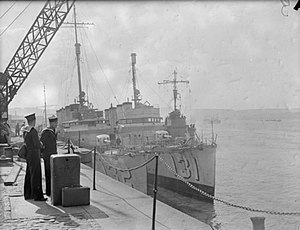HMS Campbeltown (I42)

The newly transferred HMS Campbeltown (right) alongside her sister HMS Castleton
|
|
| History | |
|---|---|
|
|
|
| Name: | USS Buchanan |
| Builder: | Bath Iron Works, Bath, Maine, USA |
| Laid down: | 29 June 1918 |
| Launched: | 2 January 1919 |
| Commissioned: | 20 January 1919 |
| Decommissioned: | In reserve from 1939 |
| Fate: | Transferred to the Royal Navy on 3 September 1940 |
|
|
|
| Class and type: | Town-class destroyer |
| Name: | HMS Campbeltown |
| Commissioned: | 9 September 1940 |
| Honours and awards: |
|
| Fate: | Expended on 28 March 1942 in a special operation against the docks at Saint Nazaire |
| Badge: | On a Field White, within an annulet Blue charged in base with a mullet White a sprig of myrtle proper. |
| General characteristics | |
| Class and type: | Wickes-class destroyer |
| Displacement: | 1,260 long tons (1,280 t) |
| Length: | 314 ft 4 in (95.81 m) |
| Beam: | 30 ft 6 in (9.30 m) |
| Draught: |
|
| Installed power: | 30,000 shp (22,000 kW) |
| Propulsion: |
|
| Speed: |
|
| Complement: | 158 |
| Armament: |
|
HMS Campbeltown was a Town-class destroyer of the Royal Navy during the Second World War. She was originally US destroyer USS Buchanan, and, like many other obsolescent U.S. Navy destroyers, she was transferred to the Royal Navy in 1940 as part of the Destroyers for Bases Agreement. Campbeltown became one of the most famous of these ships when she was used in the St. Nazaire Raid in 1942.
USS Buchanan was a Wickes-class destroyer, ordered from the Bath Iron Works, Bath, Maine, and laid down on 29 June 1918. She was launched on 2 January 1919 and commissioned into the Navy on 20 January. She had a typical inter-war career, and was placed into the reserve in 1939. She then became one of 50 destroyers transferred to the Royal Navy in 1940 after the finalisation of the Destroyers for Bases Agreement. She was transferred on 3 September 1940 and commissioned on 9 September at Halifax, Canada.
Having been formally commissioned she took passage from Halifax to Plymouth, travelling via St. Johns, Newfoundland. She arrived at Devonport Dockyard on 29 September and was taken in hand for modifications to fit her for service with the Royal Navy. The refits lasted throughout October, and on completion of the final harbour trials on 1 November she was nominated to join the 17th Flotilla operating in the Western Approaches. The next day, while carrying out sea trials she collided with SS Risoy and sustained damage, but continued and arrived safely at Liverpool, where she underwent repairs from 7 to 24 November. She then joined the flotilla.
...
Wikipedia
